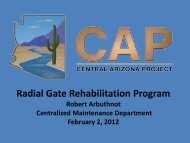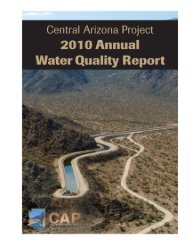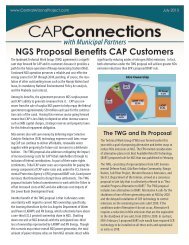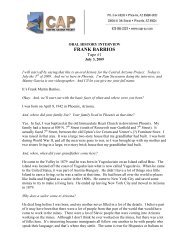Interview with Grady Gammage - Central Arizona Project
Interview with Grady Gammage - Central Arizona Project
Interview with Grady Gammage - Central Arizona Project
Create successful ePaper yourself
Turn your PDF publications into a flip-book with our unique Google optimized e-Paper software.
CAP funded. Babbitt and Cecil Andrus who was then Secretary of Interior<br />
seemed to have engineered a threat by Interior [against] <strong>Arizona</strong>—when Babbitt<br />
was Governor, before he was Secretary—that [was] the threat from the outside<br />
you needed to get everybody in <strong>Arizona</strong> to cut a deal. So we cut a deal to pass<br />
the Groundwater Management Act and essentially its consequence for the first,<br />
about twenty years of its life, was to force development to be hooked up to the<br />
pipes. Even before the Groundwater Management Act it was hard in <strong>Arizona</strong> to<br />
go outside of the city limits and sink a well and live in sort of splendid isolation<br />
that we think of as being life in the West. One of the ironies of life in the West is<br />
you really can’t be a rugged individualist. You have to get along <strong>with</strong> your<br />
neighbors well enough to share a water system. So you couldn’t really go out<br />
and dig these wells just whereever you wanted to anyway, but after the<br />
Groundwater Management Act passed you couldn’t legally do that. You had to<br />
have a hundred year assured supply and it couldn’t be a hundred years worth of<br />
groundwater. You had to be hooked up to a renewable supply, SRP or CAP<br />
being a primary renewable supply. That had an impact as we grew and boomed<br />
in the last part of the twentieth century of pushing our cities closer together.<br />
Water has always been kind of a binding agent. It’s been something that drove<br />
the cities in <strong>Arizona</strong> to be higher density, to grow in a more orderly fashion. Not<br />
so much leapfrogging as you see in parts of the country where you can be on<br />
your own water supply. The reason, when you fly into Phoenix you hit that hard<br />
edge of development and then there is either desert or farmland outside of it, is<br />
what you’re seeing is where the pipes end. That’s where the pipe extensions<br />
<strong>Interview</strong> <strong>with</strong> <strong>Grady</strong> <strong>Gammage</strong><br />
Page 63 of 91







